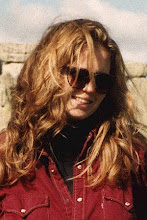
There are two ways to reach Machu Picchu. One involves a lot of time and stamina and the other one is a train journey. Reaching Machu Picchu by Inca Trail takes four days following old Inca routes in the mountains and three base camps. Definately a very ecological way of travelling and Machu Picchu is reached for sunrise. Taking the train from Poroy station just 20 mins outside Cuzco whizzes you there in just three hours. What then follows is a short bus trip up a long and extremely winding dirt track. As you move up the hill, you become aware of the architechtural feat the Incas managed to accomplish building the place. Between the peaks of Machu Picchu (the Old Mountain) and Huayna Picchu (Young Mountain) the small Incan village sits like a saddle on the mountain ridge. Places for whorship, storage and accommodation neatly fit into the agricultural terraces which lie on the outside. From the top, where the caretaker's lodge stands, the best views can be had.
 Well, in theory. When I got there, the clouds had engulfed the entire area. And as if the clouds weren't bad enough, it also rained pretty hard. The first couple of hours were basically spent seeking shelter in various huts and drying out the camera gear. At around 2pm, the hordes of tourists in their brightly coloured raincoats began to subside. They left because many needed to catch the trains back to Ollantaytambo or Poroy (Cuzco). Around an hour later, the rain also died down and the downpour gave way to a constant drizzle. It was a relief to be able to just spot the entire village below including the peak of Huayna Picchu. And then, completely unannounced the sun came out. Slowly but surely and restored the place's magic. The grey blankett was pulled away to reveal the bright greens of Machu Picchu's grass areas and the darker greens of the adjacent mountains. Persistance does pay.
Well, in theory. When I got there, the clouds had engulfed the entire area. And as if the clouds weren't bad enough, it also rained pretty hard. The first couple of hours were basically spent seeking shelter in various huts and drying out the camera gear. At around 2pm, the hordes of tourists in their brightly coloured raincoats began to subside. They left because many needed to catch the trains back to Ollantaytambo or Poroy (Cuzco). Around an hour later, the rain also died down and the downpour gave way to a constant drizzle. It was a relief to be able to just spot the entire village below including the peak of Huayna Picchu. And then, completely unannounced the sun came out. Slowly but surely and restored the place's magic. The grey blankett was pulled away to reveal the bright greens of Machu Picchu's grass areas and the darker greens of the adjacent mountains. Persistance does pay. 
I spent the night in Aguas Calientes and went up again the following morning hoping for a better day but the rain proved equally bad. At least, now reunited with my group, we tried to make the best of it.








 Ever since Erich von Däniken first mentioned the strange lines on the Nazca altiplano, I was hooked. Could it really be that aliens had created them? Or was the archaeologists' outcry that they had been created by the ancient Nazca people justified? Flying over the lines in a small four-seater Cessna plane, I got a first-hand view and could clearly see the lines criss-crossing each other without any apparent plans wasn't it for those that clearly depicted figures. There was the monkey with its curled up tail, the colibri with its long beak and the friendly figure up on a little mountain waving at us. This figure is called the astronaut. Astronaut? Well, it could easy be a figure of a being from outer space. But the archaeologiest have taken the fun out of it again and now proclaim that it is an owl-man. Did the ancient Nazca people really have a similar association we have have with owls? But the truth is, that we are actually none the wiser with this interpretation. The riddle of the lines has still to be cracked - but in whose interest would this be? Wouldn't the aura of mystery - such as described by von Däniken - be the one to be followed as it brings scores of knowledge-seeking tourists to this barren place and it helps to keep its economy afloat?
Ever since Erich von Däniken first mentioned the strange lines on the Nazca altiplano, I was hooked. Could it really be that aliens had created them? Or was the archaeologists' outcry that they had been created by the ancient Nazca people justified? Flying over the lines in a small four-seater Cessna plane, I got a first-hand view and could clearly see the lines criss-crossing each other without any apparent plans wasn't it for those that clearly depicted figures. There was the monkey with its curled up tail, the colibri with its long beak and the friendly figure up on a little mountain waving at us. This figure is called the astronaut. Astronaut? Well, it could easy be a figure of a being from outer space. But the archaeologiest have taken the fun out of it again and now proclaim that it is an owl-man. Did the ancient Nazca people really have a similar association we have have with owls? But the truth is, that we are actually none the wiser with this interpretation. The riddle of the lines has still to be cracked - but in whose interest would this be? Wouldn't the aura of mystery - such as described by von Däniken - be the one to be followed as it brings scores of knowledge-seeking tourists to this barren place and it helps to keep its economy afloat?













